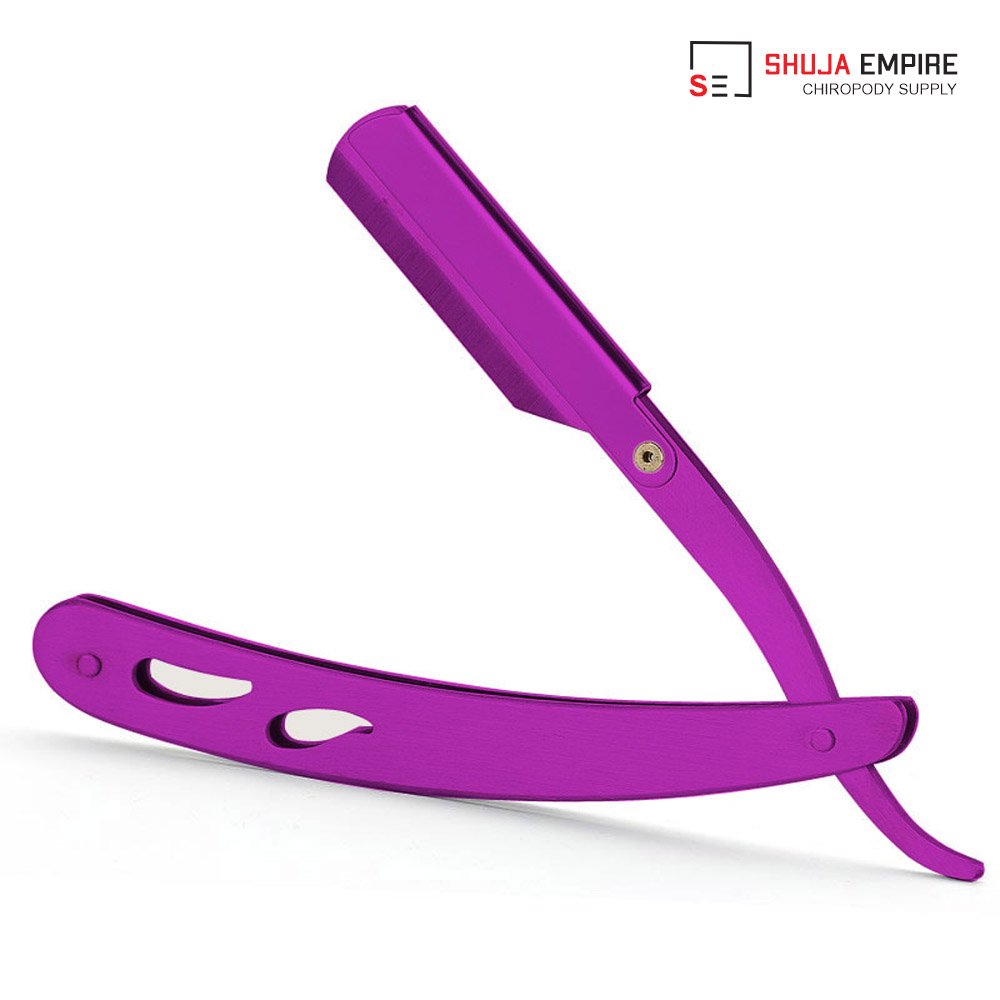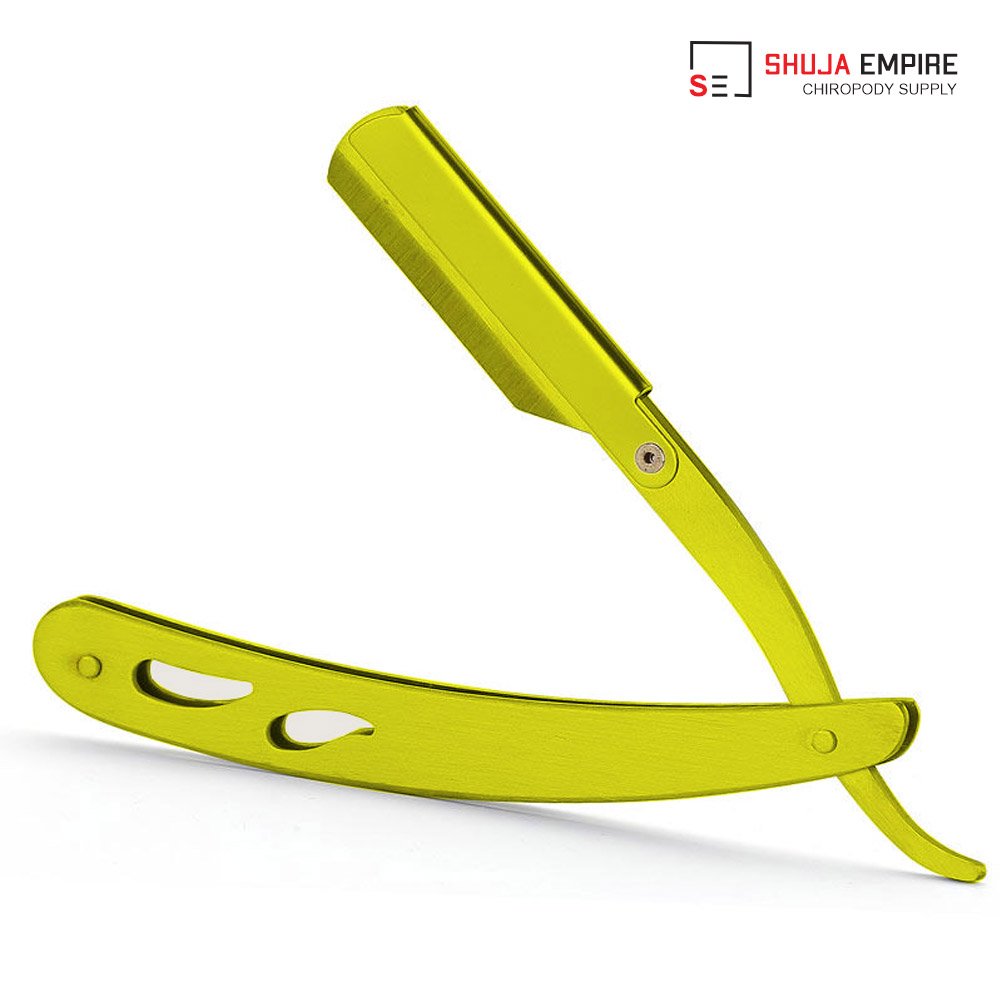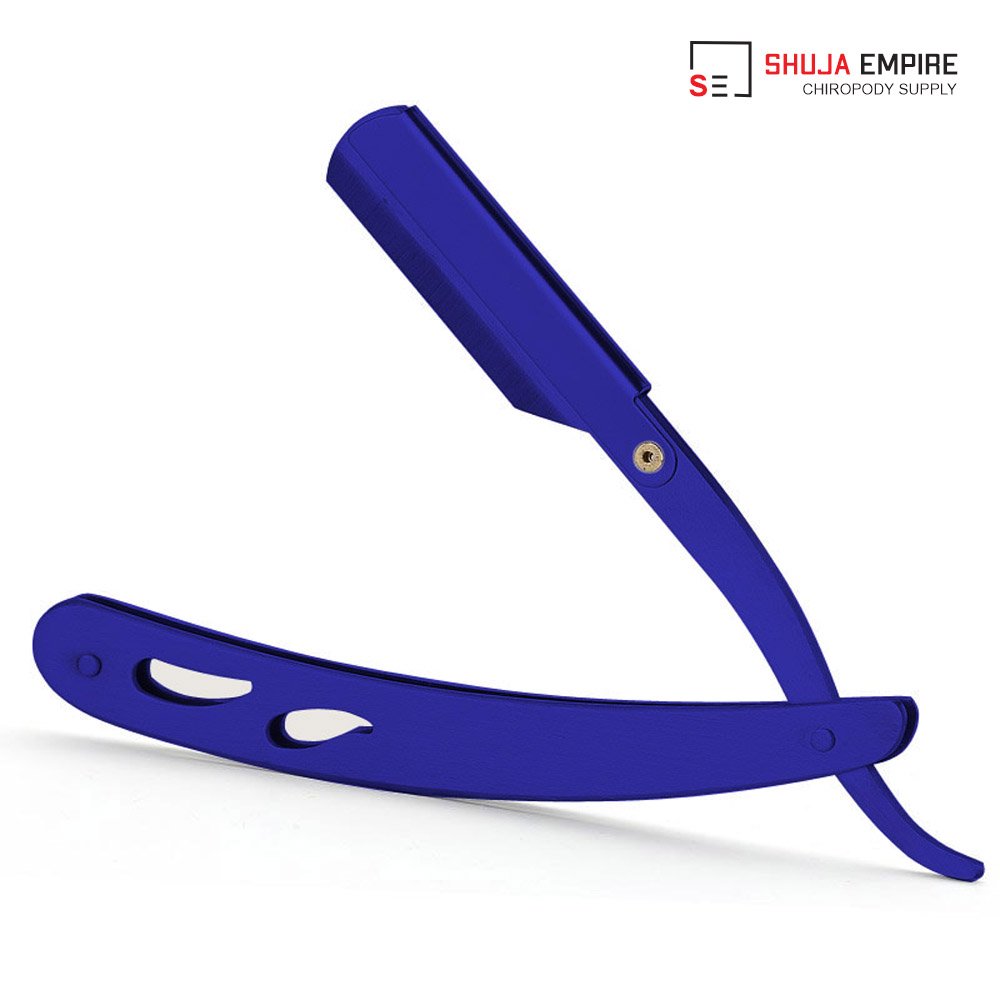WHAT IS A STRAIGHT RAZOR?
A straight shaving razor is a single blade sharpened on one edge set in a handle that is folded open or closed via a blade guard.
They can be made of different types of material from stainless steel to artisanal Damascus that is attached to the handle called the scale.
Small pivot pins on the scale hold the blade and grip together. They allow the knife to fold inside the handles, the same as a pocket knife is folded inside their handle.
Each blade is unique. Variances start with blade width, different materials, tip shape, handle material, and knife length.
BENEFITS OF USING THE RIGHT STRAIGHT RAZOR.
Once you fall in love with straight razors, it can feel like it’s making love to your face nearly every time you use them. That’s because you’re probably switching from one of the lesser forms used to extract facial hair: cartridge razors, disposable razors, or an electric razor, which not only leave a field of stubble that grows back quickly but are much less of a joy to use.
Even if you’re coming from the traditional wet shaving safety razor world (which is a close second to a modern straight razor) you’ll soon realize that no other shaving tool provides a better clean shave and smoother shave than the straight razor.
THE TOP 7 REASONS TO SHAVE WITH A STRAIGHT RAZOR
- A closer, smooth wet shaving experience
- Less irritation & razor burn
- More control and better shaving experience
- Laser-sharp shaping
- The money you will save
- It’s better for the environment
- A straight razor feels. Awesome!
Needless to say, it is easy to understand the obsession. Besides, they’re beautiful instruments and it’s tempting to want them all.
Some have qualities that make them the candidates to be the best straight razor for beginners, which is where you definitely want to start, especially if you’re new to all this wet shaving stuff. But if you find yourself swooning over a more advanced blade, you can always make it a goal to work towards.
THE BASICS TO BUYING YOUR FIRST STRAIGHT RAZOR
A traditional straight razor for a newcomer has to fill quite a few tasks. It needs to be forgiving so you don’t get cut, provide a smooth shave, stay razor-sharp to keep your chin as bare as the day you were born, and make you look as suave as 007. All while doing it at a reasonable price however don’t shop by price a cheap straight razor might send you straight to the emergency room.
The best straight razors for beginners should check all boxes. But, doesn’t it feel like you can look at all of the different traditional straight razors and premium straight razors all day long, despite detailed product descriptions, never know if you’re making the right decision?
Recommendations for specific products can be helpful, but when you purchase straight razors especially something nicknamed a “cut-throat razor.”
It’s a serious tool, with a sharp blade. What you really need is the key to understanding the language. Once you know how to identify a premium straight razor for starters, you can breeze through the suggestions and decide which one you want for yourself.
There are many different kinds of blades in our shop, so we’re here to help point the way to the starter blades and help you understand how to work your way up to the slightly more advanced straight razor blades we have for experienced shavers.
Everything you need to know to buy your first straight razor and the key to understanding the rest is contained below. We’ll go through what types of razors you should start with, get some tips on how to shop for disposable razor blades that Shavettes and Barbarettes come with, look at some great examples so you can shop with confidence.
STRAIGHT RAZOR ANATOMY: IMPORTANT TERMS AND CONCEPTS
Straight razors are known by many names but all the same, often names as a straight edge, a cut throat razor, barber, open-blade razor, straight edge, straight blade and straight-edge razor. Even though a straight razor blade is essentially the blade and the handle, the best straight razors for newcomers have some features that make them easier to use.
JIMPS
Jimps are indentations along the lower portion of the smooth side of the blade (called the tang) where you rest your fingers while shaving. They provide traction, which makes it easier for the blade to stay steady in your hand. Not all straight-edge razors shave Jimps and once you master the skill, they may no longer be needed. However, plenty of lifelong wet shavers prefer razors that come with Jimps for both style and function.
SHOULDER
The shoulder of the blade is a depression on the face that marks where the sharp end of the blade turns into the tail. The shoulder is really more cosmetic, but it can be useful for you to get a feel of where the smooth parts stop and the sharp parts begin when you’re just starting out.
WIDTH
Straight-edge razor blades are measured according to their width and novice shavers should take note. There’s a slight difference in performance between a wide and narrow blade. Thicker blades can sometimes deliver a more aggressive cut. However, wider blades can also make it harder for you to see what you are doing, which is not ideal for first-timers.
More narrow blades are best for rookies. They’re sharp, but they let you see what you’re doing, especially when hitting difficult corners around the nose and ears. Plus, they’re easier to keep sharp unlike honing by gliding up and down the strop.
Eventually, you may get enough of a feel for wet shaving with a straight edge to not even have to see what is going on, but when you’re just starting out you may need this extra field of vision. Wider blades last longer but are also a little more challenging to sharpen using a leather strop.
SO, WHAT’S THE MEASUREMENT SYSTEM ALL ABOUT?
Blades are measured in increments of ⅛ inches from the toe of the blade (sharp bottom edge of the razor head) to the spine. So a 4/8 blade is half an inch wide and a 6/8″ blade is ¾ of an inch wide. A good width straight razor for beginners is 5/8 inch.
BLADE GRIND
The grind refers to the flexibility and sharpness of the blade. Small variations in the shape of the blade a have big impact on the shave it provides.
The word “hollow” is used to describe the grind of the types of blades new shavers should gravitate towards. Hollow grinds doesn’t mean there’s empty space inside the blade, it just means that more of the metal has been taken off, leaving a longer, more supple, and forgiving blade. Most great straight razors today come in either a full hollow or half hollow.
MOST COMMON GRINDS:
- Full hollow grind: A long, thin, sharp yet forgiving blade
- Extra hollow grind:A more fine edge than a full hollow, it’s sharper and may be too flexible for newcomers
- Singing hollow grind: Ultra-thin blade made for pros
- Half hollow grind: Thicker, a slightly wedged design that is only offered by a few straight razor manufacturers
- Flat or straight grind:Commonly called a “wedge” type ground straight razor attributed to rigidity and torsion-resistance. You will often find this grind on narrow straight razors to allow very precise shaving.
STAINLESS STEEL BLADE VS. CARBON STEEL 101
Ah, which to choose: Carbon or stainless steel (also called inox). The answer may not be what you think.
If you’re coming from the world of cartridges and safety razors, you might’ve heard that stainless steel is the way to go. Stainless steel doesn’t oxidize in moist environments like so it stays sharper longer and is easier to maintain than carbon steel.
But there’s a different kind of thinking at play when it comes to picking a good straight-edge razor. A Safety razor pushes across your face rather than pull, like safety razors, and need a finer, less coarse blade. Stainless steel works, but it can be a little harsher, which can make it a bit more difficult to strop and sharpen.
The benefit of carbon is that it is very easy to strop and keep a sharp edge, which makes it a great metal for straight razors and a great choice for beginners. Carbon steel is the original material many of the most important names in shaving like Boker started back in the 19th century and is the primary metal they use to make them today.
The significant difference between these two is that chrome is added to the alloy to create stainless steel. Chrome makes the atomic structure of the stainless steel more coarse.
Unfortunately, carbon steel doesn’t have protection to prevent oxidation or rust like stainless steel, so if you’re a slob (you know who you are), there are a few things you should know.
TIPS FOR USING A CARBON BLADE:
Completely dry your razor after use
Store the razor in a cool dry place
Cover it with a light coat of camellia oil to protect the blade from moisture (petroleum jelly is a good substitute).
Look for blades that come with protective coatings
PRO TIP:
High-blade quality metals sharpen better. No matter if carbon or stainless steel, blades made from good metal should produce a clear ringing sound if you very carefully place the point of the blade under your thumbnail and give a gentle nip. You don’t have to buy an artist club ss, but you do need to make sure the razor is made from quality steel.
WEIGHT & BALANCE: HANDLES
The scale, (handle or blade holder), can seem like just the fun part. They can be stunning pieces of art — some are even collector’s items and they come with beautiful and intricate designs. But there’s more to the blade holder story: weight and balance. This part may be nestled deep into this article, but this may be the most important shaving fact you learn today.
The ideal straight-edge razor balance should be at the pivot pin, where the blade meets the handle. Hard stop. Repeat. The center of balance for a straight razor is at the pin where the blade and the handle meet. This balances the razor so that it is easier to hold in any direction, enabling you to get your neck just as easily as you can with your mustache.
But it’s really a personal choice. Some guys like a heavier blade, others like the feel of a dense handle. Either way, start in the middle so you can master the feeling first.
TIPS FOR PICKING A HANDLE:
Heavier Handles:
A metal or stainless steel body tends to be heavier. Most of the work of applying pressure is done by the weight of the blade itself. With less force needed from you, they can be a good option for those with sensitive skin.
Lighter Handles:
Wood or resin tends to be lighter and gives you more control of the pressure. This can come in handy in areas where detail is needed.
Feel free to start with either type of blade holder. Some woods and other lighter materials can sometimes cost less, which makes them a good place to start, plus they teach you how to use a blade properly. But there’s no hard and fast rule that says where you should start.
BLADE POINT
Many straight razors can have different kinds of blade points. Found at the top of the blade, on the side of the spine, the point is used to remove hair from hard-to-reach parts like your ears and nose and to give definition to the shape of the beard.
When you buy your first straight razor, look for a rounded point “round point” blade; skip anything with a square point. A rounded shaving head is still sharp and gives a close shave, but it is a lot safer to steer than their square point blade cousins and others like the French point, Spanish point, or Barber’s Notch. You may find a rounded shaving head to be a little less exacting, but they’re a lot safer, especially when starting out.













Reviews
There are no reviews yet.